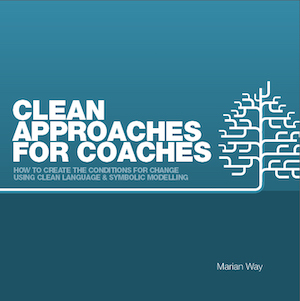First published in
Clean Approaches For Coaches: How to create the conditions for change using Clean Language and Symbolic Modelling, Marian Way
(Clean Publishing, 2013, pp. 10-11).

From the outside, clean approaches to coaching can look a lot like other coaching methods. But this is an illusion of perspective. From the inside, from the client and coach viewpoint, the process is probably like nothing either have experienced before.
The most obvious difference between clean and other kinds of coaching is David Grove’s Clean Language which he began developing in the early 1980s. At that time the centrality of metaphor to thought, word and deed was a revolutionary idea. Today Clean Language still forms the most sophisticated and elegant means of working with clients’ metaphors. Yet Clean Language needs to be used within a methodology or framework, and this is where Symbolic Modelling comes in. When clients are facilitated to attend to their metaphorical language and non-verbal behaviour they get to know themselves in a new way and they start to think differently.
David Grove said Clean Language has to be simple because clients are complex. By not introducing any content, Clean Language limits distractions. This means the client has little choice but to work with who they are – whether they like that or not. They can fool themselves and they can fight themselves, but sooner or later they realise they are only doing this to stay the same. And then what do they do? We don’t know. They don’t know. But we’re willing to facilitate them to find out.
When and how change happens can rarely be predicted (and the effects of change are even less predictable). We’ve seen a client experience a significant change in the first few minutes of a session – much to his surprise and our shock. Another felt something shift as she struggled to open our front door to leave after a session. Often a client will find their life changing months later. Occasionally nothing much seems to change, and maybe this is for the best. We don’t assume change is always beneficial.
We believe minds evolve and behaviour changes through nonlinear processes. This means there is no direct relationship between what coaches do and clients changing – so we don’t try to make change happen. Instead we look for patterns in the client’s behaviour that indicate the conditions under which his or her system will change itself – spontaneously and naturally.
To do this clean coaches have to set aside their own inner world and make the client’s inner landscape the focus of their joint attention. Many coaches think they already do this, and they may, but not to the extent that clean coaches do.
Furthermore, the clean coach doesn’t have a toolbox full of change techniques and they don’t offer advice – no matter how good it is. If they aren’t allowed to introduce any content of their own, what can they do? The clean coach has only one ‘tool’: Everything they do – every word, every gaze and every gesture – has the purpose of inviting the client to attend to aspects of his or her experience and to notice, consider and reconsider how they do who they are; and to wonder what they would like to have happen. We call this facilitating self-modelling.
Becoming an excellent clean coach takes some doing. Mostly it takes disengaging from the myriad of explanations and beliefs acquired about how the mind works and how it changes. These generalisations can prevent us from seeing the uniqueness of the individual in front of us, blind us to what is happening in the moment and block us from responding to the client’s idiosyncratic ways of staying the same and changing.
When you disengage you are released from needing to understand, from making things happen, and from being the expert. Less really is more when you realise the client is always unconsciously providing clues and indicators about which way to go next. Then the blindingly obvious becomes visible and every step is an adventure with the unexpected waiting to surprise both of you at any moment.
Marian Way has produced a beautiful and well-thought-out book that concentrates on the practicalities of becoming a clean coach without compromising the soul of the process. Clean Approaches for Coaches manages to combine simplicity with depth, accessibility with thoroughness, and clarity with the messiness of real life. The book is full of images, metaphors and transcripts from Marian’s considerable first-hand experience. These provide an insider’s perspective; which is what makes this book so rich, congruent and creative.
We expect Clean Approaches for Coaches will intrigue you enough that you will want to experience Clean Language and Symbolic Modelling both as a coach and as a client. We also expect you to be inspired to read this book again and again so you acquire a deep appreciation of the wisdom distilled in its pages. You couldn’t have a better grounding than the book in your hands.
James Lawley and Penny Tompkins
Sydney, Australia, 1 February, 2013








